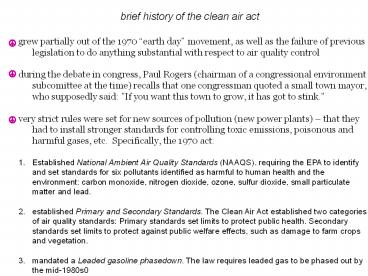brief history of the clean air act - PowerPoint PPT Presentation
1 / 10
Title:
brief history of the clean air act
Description:
... a small town mayor, who supposedly said: 'If you want this town to grow, it ... against public welfare effects, such as damage to farm crops and vegetation. ... – PowerPoint PPT presentation
Number of Views:24
Avg rating:3.0/5.0
Title: brief history of the clean air act
1
brief history of the clean air act
- grew partially out of the 1970 earth day
movement, as well as the failure of previous
legislation to do anything substantial with
respect to air quality control - during the debate in congress, Paul Rogers
(chairman of a congressional environment
subcomittee at the time) recalls that one
congressman quoted a small town mayor, who
supposedly said "If you want this town to grow,
it has got to stink." - very strict rules were set for new sources of
pollution (new power plants) that they had to
install stronger standards for controlling toxic
emissions, poisonous and harmful gases, etc.
Specifically, the 1970 act - Established National Ambient Air Quality
Standards (NAAQS). requiring the EPA to identify
and set standards for six pollutants identified
as harmful to human health and the environment
carbon monoxide, nitrogen dioxide, ozone, sulfur
dioxide, small particulate matter and lead. - established Primary and Secondary Standards. The
Clean Air Act established two categories of air
quality standards Primary standards set limits
to protect public health. Secondary standards set
limits to protect against public welfare effects,
such as damage to farm crops and vegetation. - mandated a Leaded gasoline phasedown. The law
requires leaded gas to be phased out by the
mid-1980s0
2
then, in 1977, when it became clear that older,
aging power plants were not being retired, the
New Source Review provision was added, which
required that any increases in pollution from
older plants (due to increased output, etc.) must
be matched with upgrades for pollution
control the EPA estimates that this New Source
Review policy has helped reduce pollution levels
by greater than 100 million tons In 1979, the
National Academy of Sciences reports that leaded
gasoline is the largest single source of
atmosphere lead. Then, in 1980, the Reagan
administrations Task Force on Regulatory Relief
(chaired by Vice President George H. W. Bush)
proposes abandoning the phase-out of leaded
gas!!! When EPA Administrator Ann Gorsuch
admits to a gas refiner that the agency would
not enforce lead limits, the resulting bad
publicity prompts a reversal ... and an
unplanned speedup of the leaded gasoline
phase-out.
3
Almost all of the pollutants targeted in the
clean air act legislation have decreased since
1970 Carbon Monoxide 31 decreaseSulfur
Dioxide 27 decreaseParticulate Matter (PM-10)
71 decreaseLead 98 decrease
source http//www.edf.org
LA in 1972
4
(No Transcript)
5
Images from Purves et al., Life The Science of
Biology, 4th Edition
6
1) jellyfish breathe through their skin, why
cant we??
Oahu, Hawaii photo by J Hodin
7
2) oxygen passes from the digestive to the
circulatory system at the alveoli (sacs at the
ends of bronchiole passages in the lungs). Why,
for example, does oxygen not just pass into the
circulatory system in the mouth or the throat?
Those cells have blood supplies nearby too!
from K. Schmidt-Nielsen Animal Physiology (1997).
8
3) long distance runners often train at high
altitudes. This gives them greater capacity to
gain oxygen during exercise. How?
Catherine Ndereba womens Boston Marathon
champion 2000, 2001, 2004
http//kenyapage.net/sports/kenya-track.html
9
4) blood doping is an illegal method that some
long distance runners have used to increase
their oxygen carrying capacity. How does it
work? (hint 1 its similar to high altitude
training but without all the hard work) (hint 2
its undetectable)
PhysioRoom.com
10
5) breathing is a muscular process involving the
diaphragm. When the diaphragm contracts, air is
forced into the lungs. How?
from Purves et al., Life The Science of Biology,
4th Edition































